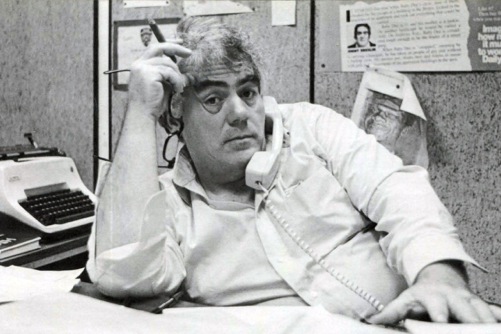Lions before print journalism's winter in HBO's Breslin and Hamill: Deadline Artists
01/23/19 15:01

By ED BARK
@unclebarkycom on Twitter
The lede is inspired.
HBO’s Breslin and Hamill: Deadline Artists (Mon., Jan. 28th at 8 p.m. central) begins with visuals of New York subway passengers transfixed by their cell phones. Then cut to an earlier era, when rail riders were immersed in the Manhattan tabloids that once housed the punchy prose of columnists Jimmy Breslin and Pete Hamill.
“This was the last expression of great, 20th century muscular American journalism,” an unidentified admirer says near the end of this nearly two-hour documentary film. It’s really not too grand a statement about two guys who lived, breathed and emboldened the printed word.
Although Deadline Artists profiles both of them, the late Breslin (who died in 2017 at the age of 87) is the swaggering star of this time capsule. Hamill, living on at the age of 83, is far less bombastic but “got the pretty girls” in the vernacular of those times. He most famously dated Jackie O, and also squired Linda Ronstadt and Shirley MacLaine. But if Hamill had the looks, the unrepentant Breslin had the guts. By the year 2015, both men looked frail and spent while seated next to one another for the purposes of this evocative film. Breslin remained pretty grouchy while the cheerier Hamill arrived in a wheelchair. It’s still something to see.
Deadline Artists is principally produced and directed by veteran journalist and latter day cable news network gadfly Jonathan Alter, who was a Newsweek columnist and senior editor back in times when Breslin still roamed untamed and dubbed himself “JB No. 1.”
Alter recalls the time Breslin phoned to warn against anyone at the magazine “f***king” with him. He described himself as “the John Gotti of journalism,” a reference to the cutthroat mobster that Breslin had both covered and knew personally. “I like bad boys,” Breslin once told an interviewer. “Legitimate people are boring. They’re terrible.”
Breslin had the balls and the gall to take on “subway vigilante” Bernhard Goetz, who in 1984 was lionized by most New Yorkers after shooting four young black men who had taunted him. “Criminals Think Twice Or We Will Goetz You!” a sign of the times read.
Writing extensively about the incident, Breslin said that Goetz in fact was more a cold-blooded killer than hero. What if his victims had been white? Would he also have fired away?
On a famous episode of his once immensely popular talk show, Phil Donahue opined, “Mr. Breslin, sir, you do appear to be whistling a very lonely tune . . . Your speeches are not playing in New York City.”
Breslin didn’t care, and kept saying so. And in a subsequent police tape, Goetz came off as a remorseless, cold-blooded killer who said in part, “If I had more bullets, I would have shot ‘em all again and again. My problem was I ran out of bullets.”
He also went to bat for a New York City cop named Cibella Borges, who got kicked off the force after she was found to have posed nude for something called Beaver magazine. The police threatened to boycott Breslin’s paper at the time, The New York Daily News. He remained unbowed, chiding the “deplorable shape” of most NYPD officers compared to the trim young woman they had ostracized. Borges eventually was reinstated, and in a reunion of sorts decades later, she thanks Breslin for his advocacy. “Oh shut up, God bless ya,” he says with typical gruffness.
Deadline Artists also recounts Breslin’s up close and personal role in the Son of Sam serial murders, and his incredibly inventive and distinctive writing about the assassination of John F. Kennedy, when he alone had the foresight to seek out the late president’s African-American gravedigger while thousands of rival reporters basically parroted the same stories. He also wrote two big bestsellers, “Can’t Anyone Here Play This Game?” and “The Gang That Couldn’t Shoot Straight.”
But Breslin’s outsized mouth bit him hard when at age 61, he lamented that his wife no longer was around to do the household chores now that she had been elected to the City Council. A Korean-American colleague of his at New York’s Newsday took umbrage and accused Breslin of “spewing sexism” in a personal message to him.
He responded with a newsroom tirade that branded the woman “slant-eyed” and a “yellow cur.” Breslin’s old newspaper, The New York Daily News, ran a story headlined, “Breslin rages, slurs: Spews racial epithets.”
A two-week suspension ensued after Breslin issued an apology that really wasn’t one. “Once again I am wrong. JB No. 1.”
Gail Collins, longtime columnist and reporter for The New York Times, says in a fresh interview that Breslin was “terrible in many ways, but his sense of sympathy was just amazing.”
Others interviewed for Deadline Artists include the aforementioned MacLaine, the late Tom Wolfe, Gloria Steinem, Garry Trudeau, Gay Talese, Spike Lee, Robert De Niro and Tom Brokaw, who calls Hamill “so authentically male” -- whatever that means.
Hamill otherwise can’t help but pale in comparison to the bombastic Breslin. He initially was hired by The New York Post as their answer to Breslin. But they later ended up being colleagues, for a relatively short while, as columnists for the Daily News. Imagine what a one-two punch that was.
Hamill remains proud of making Richard Nixon’s “Enemies List” and of being singled out by Vice President Spiro Agnew in the aftermath of his “nattering nabobs of negativism” speech aimed at the administration’s media detractors.
He also became close with Robert F. Kennedy, at one point writing a letter to him that encouraged a run for the presidency. In retrospect, he “made a terrible mistake as a journalist,” Hamill says. “I had become friends with Robert Kennedy . . . I never was friends with a politician again.” Both Hamill and Breslin were on the scene when Kennedy was assassinated in a Los Angeles hotel after winning the 1968 California presidential primary.
In Breslin’s view, which he held to the end, “You’re not put on this earth to be happy. You’re really not.”
Hamill, last seen drawing on an artist’s pad while sitting in his wheelchair outside Prospect Park, in contrast seems to be a study in reasonably happy contentment.
The Daily News couldn’t afford either of them now. Back in 1988, the paper employed 400 reporters and editors,” according to Deadline Artists. Thirty years later, it was down to 45.
“There’s always going to be new people,” Spike Lee says hopefully.
You can read a lot of them on Twitter these days. Many hide behind anonymous “handles.”
GRADE: B+
Email comments or questions to: unclebarky@verizon.net
